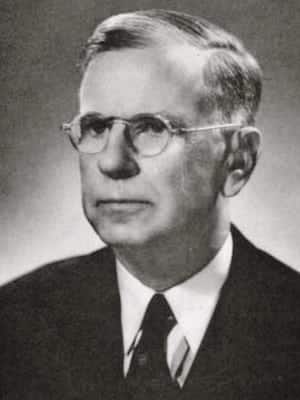Ernest William Goodpasture
Ernest William Goodpasture (1886 – 1960) was an American pathologist.
He published renowned comprehensive experimental research in viral biology on numerous viral diseases, such as mumps, intra-axonal transmission of herpes virus in experimental encephalitis, and observations of live virus present in some cellular inclusions. In 1939, Goodpasture co-published a breakthrough work on cultivating the fowl-pox virus on chick embryos, which led to vast adoption of this viral cultivation method.
In addition to his pioneering research, Goodpasture was a proficient pathologist and teacher, holding numerous professor appointments throughout his career.
Goodpasture is eponymous with Goodpasture syndrome (1918), after autopsy descriptions of a young man who had hemorrhagic consolidation of the lungs and glomerulonephritis following influenza infection.
Biography
- Born 17 October 1886, Montgomery County, Tennessee
- 1903-07 – Completed B.A. degree from Vanderbilt University, Tennessee
- 1908-12 – Graduated with M.D. degree from the School of Medicine, Johns Hopkins University
- 1912-15 – Further postgraduate training supported by a Rockefeller Fellowship as a fellow, instructor, then resident pathologist under Nobel Laureate George Whipple, in the Department of Pathology of Johns Hopkins University
- 1915-18 – Resident pathologist at Brigham Hospital, and instructor in pathology at Harvard Medical School
- 1918 – Lieutenant, Junior Grade, U.S. Naval Reserve Force during WW1, serving as a pathologist in the laboratories of the Chelsea Naval Hospital, where he performed autopsies on patients during the influenza pandemic
- 1919-1921 – Assistant professor of pathology at Harvard Medical School Department of Pathology
- 1921 – Travelled briefly to Manila, Philippines to undertake research as an assistant professor of pathology, then head of the Department of Pathology in the College of Medicine and Surgery of the University of the Philippines
- 1922 – Director of the ‘William H. Singer Memorial Research Laboratory’ affiliated with Allegheny General Hospital in Pittsburgh
- 1924-1955 – Professor of Pathology and pathologist at the School of Medicine of Vanderbilt University. Studied abroad at the University of Vienna under Carl Rothberger, continuing studies on the neural transmission of viruses and inclusion Negri bodies of rabies. Research works focussed on the pathogenesis of viral disease, nature of viruses, and proliferation in animal body and laboratory culture
- 1945-50 – Dean of Medicine at the School of Medicine of Vanderbilt University
- 1939 – President of the American Society for Experimental Pathology; Honorary M.S. degree from Yale University
- 1940 – Vice-president of the American Association for the Advancement of Science
- 1941 – Honorary D.Sc degree from the University of Chicago
- 1950 – Honorary D.Sc degree from Washington University
- 1957 – Honorary L.L.D. degree from Tulane University
- 1958 – Scientific director of the Armed Forces Institute of Pathology
- 1959-60– Associate in Pathology at the University of Mississippi Medical Center
- 1960 – Emeritus Professor of Pathology at Vanderbilt University
- Died 20 September 1960, Nashville, Tennessee
Medical Eponyms
Goodpasture syndrome (1919)
Circulating anti-GBM (glomerular basement membrane) antibodies targeted against the noncollagenous domain of the α-3 chain of collagen IV associated with glomerulonephritis and pulmonary haemorrhage. Immunofluorescence significant for immunoglobulin G on the basement membrane in renal or lung tissue.
- McCullum-Goodpasture stain
Key Medical Attributions
Goodpasture was a pioneer in the field of virology. He is renowned for developing a widely used virus culture medium of chick embryo cells, identifying the aetiology of mumps, intra-axonal transmission of herpes virus in experimental encephalitis, and demonstrating living virus in some cellular inclusions. He also published other works in non-infectious pathology, such as on haemorrhagic pancreatitis (with George Whipple), liver metabolism of fibrinogen, cell overgrowth and the development of cancer.
Controversies
Goodpasture performed autopsies on patients in a 1918 flu epidemic (note influenza was not isolated until 1933) and he was interested in what was killing these young men. He found two unusual patients. One patient was an 18-year old who had:
extensive hemorrhagic consolidation of the lungs associated with focal necrosis of alveolar walls and hyaline membranes as well as necrotising and proliferative glomerulonephritis
The sections were discarded and Goodpasture thought nothing more of his 1919 report until Drs Clare Stanton and Dr John Range reviewed his literature after having similar patients in their Melbourne Hospital in the 1950s. They wrote an article in 1958 stating:
… as the ethology of the condition is obscure, brevity and precedence are urged to justify the name ‘Goodpasture syndrome.
Dr Goodpasture wrote to the two communicating that his name should not be attached as he had not fully studied the disease.
Major Publications
- Goodpasture EW, Whipple GH. Acute haemorrhagic pancreatitis. Surgery, Gynecology and Obstetrics. 1913; 17: 541-47.
- Goodpasture EW. Fibrinogen. II. The association of liver and intestine in rapid regeneration of fibrinogen. Am. J. Physiol. 1914; 33: 70-85.
- Goodpasture EW, Burnett FL. The pathology of pneumonia accompanying influenza. United States Naval Medical Bulletin. 1919; 13(2): 177-97.
- Goodpasture EW. Bronchopneumonia due to hemolytic streptococci following influenza. J Am Med Assoc. 1919; 72: 724-25.
- Goodpasture EW. The significance of certain pulmonary lesions in relation to the etiology of influenza. American Journal of Medical Sciences. 1919; 158 (6): 863. [Goodpasture syndrome]
- Goodpasture EW, Teague O. Transmission of the Virus of Herpes Febrilis along Nerves in experimentally infected Rabbits. J Med Res. 1923;44(2):139-184.7.
- Teague O, Goodpasture EW. Experimental Herpes Zoster. J Med Res. 1923;44(2):185-200
- Goodpasture EW. The pathways of infection of the central nervous system in herpetic encephalitis of rabbits contracted by contact, with a comparative comment on medullary lesions in a case of human poliomyelitis. Am J Pathol. 1925;l(l):29-46.
- Goodpasture EW. Certain factors determining the incidence and severity of herpetic encephalitis in rabbits. Am J Pathol. 1925;l(l):47-55.
- Woodruff AM, Goodpasture EW. The susceptibility of the chorio-allantoic membrane of chick embryos to infection with the fowl-pox virus. Am J Pathol. 1931;7(3):209-22.
- Goodpasture EW, Johnson CD. The etiology of mumps. Am J Hyg. 1935; 21(l): 46-57.
References
- Long ER. Ernest William Goodpasture (1886-1960): a biographical memoir. National Academy of Sciences. 1965.
- Goodpasture EW. Landmark publication from The American Journal of the Medical Sciences: The significance of certain pulmonary lesions in relation to the etiology of influenza. Am J Med Sci. 2009;338(2):148-151
- Collins RD. Dr Goodpasture: “I was not aware of such a connection between lung and kidney disease.” Annals of Diagnostic Pathology. 2010; 14(3): 194-198.
- Bibliography. Ernest William Goodpasture (1886 – 1960). WorldCat Identities

eponym
the person behind the name
Doctor in Australia. Keen interest in internal medicine, medical education, and medical history.

